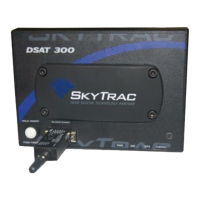DSAT-300 USER GUIDE 20
Document Rev. 1.015 DOC0594 Page 20 of 28
Restricted Proprietary and Confidential Information
13.4 TSO COMBINATION ANTENNA
The DSAT-300E can also be utilized with a combination, active L1 GPS/Passive low profile, molded radome, Iridium
antenna (P/N:STS0021). This recommended system antenna is only available directly from SKYTRAC Systems Ltd
and is permanently installed on the outside of the aircraft. Please contact SKYTRAC Systems to discuss the
feasibility of using an alternate antenna if required.
The combination antenna must also be installed at least three feet away from any other GPS antenna. It is
imperative that the antenna be mounted outside, as high as possible and in a horizontal position on the aircraft,
attempting to achieve a 360-degree view of the sky with minimal obstructions.
IMPORTANT NOTE:
This antenna uses an SMA and a BNC connector for the GPS jack and TNC
connectors for the L Band or Iridium jack. Immediate damage will occur to the
DSAT300E if either cable is connected to the wrong jack.
The use of RG-400 low-loss coaxial cable restricts the maximum length of the cable to 18 ft. If a longer run is
required, use lower loss coax cable like EMTEQ PFLX240-500 (recommended) or ECS 311501 and refer to
manufacturers’ specifications for attenuation at 1.6 GHz. Attenuation of equal or less than 3dB is required. The
bond between the airframe and the antenna needs to be 10 milliohms or less.
Prepare the mounting location by drilling holes in the aircraft skin or through a mounting plate. Use a doubler plate
of 4 x 6 inches if antenna is installed on a non-metallic aircraft surface to create a ground plane. The plate must
have an electrical connection to the antenna ground.
Installation of an antenna on the aircraft should be performed only as defined by the aircraft
manufacturer or in accordance with TC or FAA approved engineering data. Special caution
must be observed when installing antennae in pressurized aircraft.
NOTE: The combination antenna includes a rubber seal that must
be properly installed into the groove on the underside of the
antenna prior to mounting the antenna. This seal acts as an
environmental seal from the outside atmosphere. Any connections
that are not protected from the outside atmosphere by the rubber
antenna seal should have an environmental seal applied to them
during installation.

